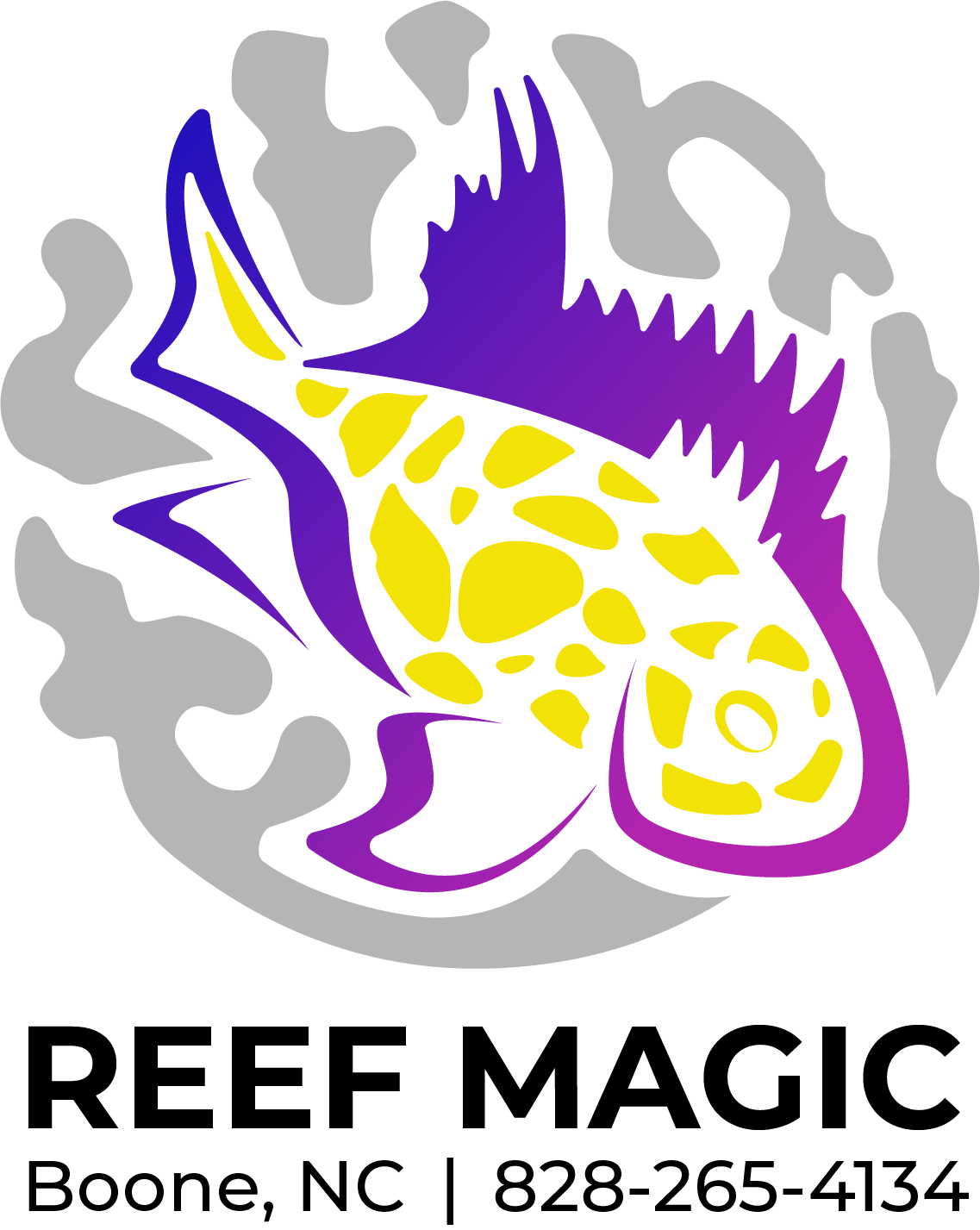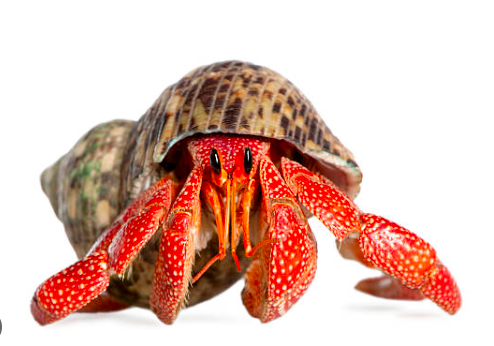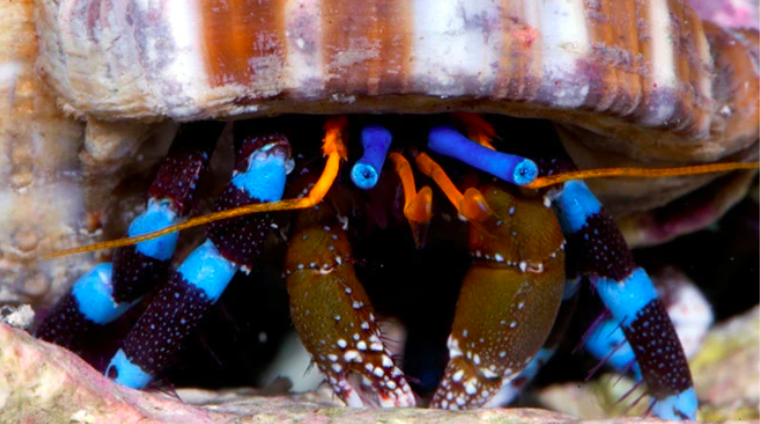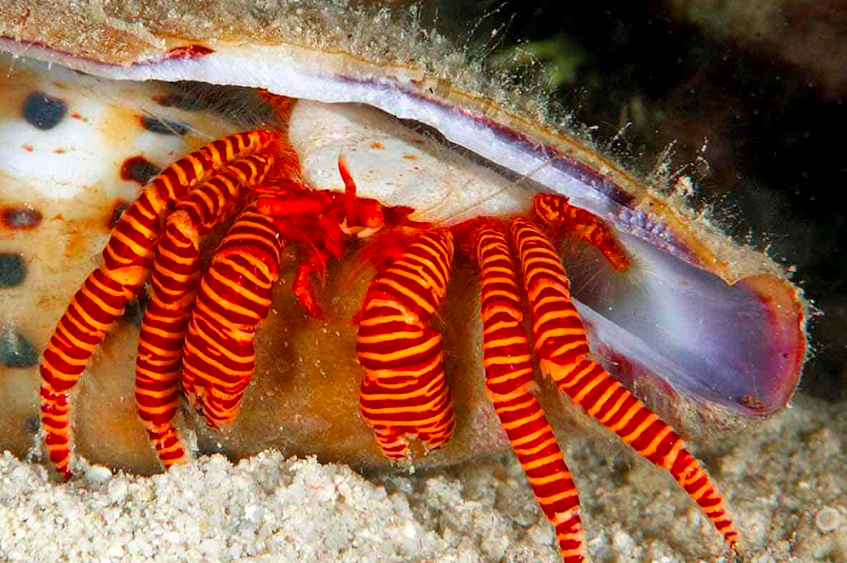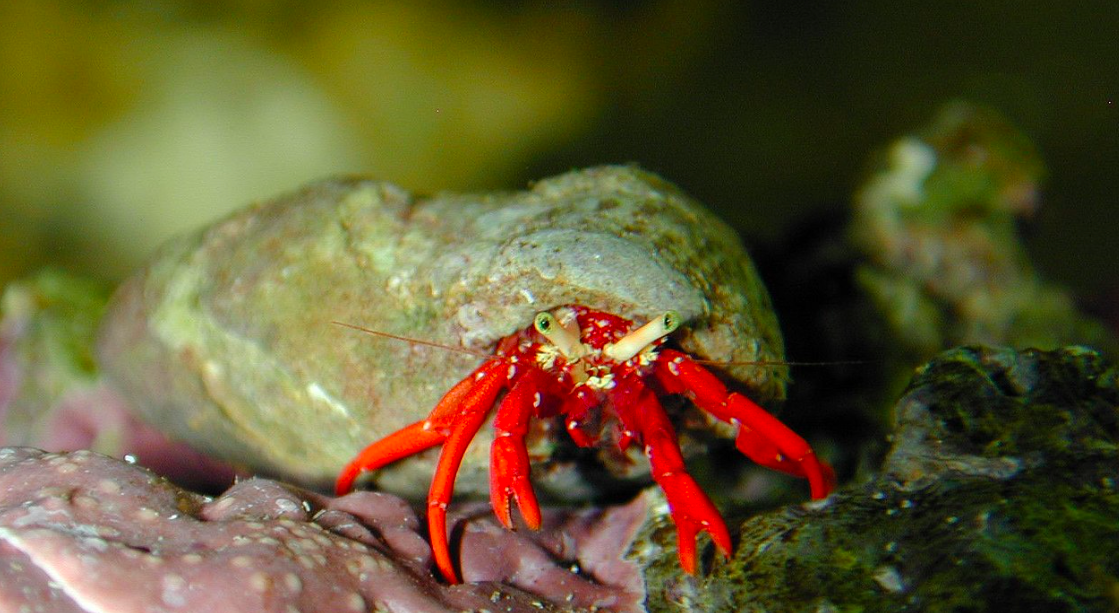Top 5 Rare Hermits For Your Reef
#5 Red Spotted Hermit Crab
The Red Spotted Hermit Crab, scientifically known as Dardanus megistos, is a species of hermit crab that is popular in the aquarium hobby. Here's a brief overview of the Red Spotted Hermit Crab:
Appearance: Red Spotted Hermit Crabs have a unique and eye-catching appearance. Their exoskeleton is typically brown or reddish-brown in color with bright red spots scattered across their body and legs. They have long, slender legs and two asymmetric claws, with the larger one being used for defense and grabbing onto shells.
Size: These hermit crabs can grow up to about 2 inches (5 cm) in size, although their actual size may vary depending on factors such as habitat and nutrition.
Behavior and Habitat: Red Spotted Hermit Crabs are primarily marine creatures found in tropical and subtropical regions, particularly in the Indo-Pacific region. They are typically found in reef environments, including coral reefs and rocky areas. In the wild, they are scavengers, feeding on algae, detritus, and leftover food.
Tank Requirements: If you plan to keep Red Spotted Hermit Crabs in an aquarium, it's important to provide a suitable habitat for them. A tank with a sandy substrate and ample hiding places, such as rocks or caves, will allow them to exhibit their natural behavior. They are generally peaceful and can be kept in a community aquarium, but it's essential to ensure sufficient food availability.
Diet: Red Spotted Hermit Crabs are omnivorous and will eat a variety of foods. They primarily feed on algae, detritus, and leftover food in the aquarium. It's beneficial to provide a well-rounded diet that includes algae-based foods, meaty preparations, and occasional treats like seaweed or blanched vegetables.
Red spotted Hermits make for a great iconic addition to any reef aquarium. They are an Eyecatcher for anyone lucky enough to own one.
#4 Electric Blue Hermit Crab
Picture from: https://vividaquariums.com
The Electric Blue Leg Hermit Crab (Calcinus elegans) is a rare exlcusive variation of the blue legged hermits found exlusively from the Marshall Islands. These crabs get their names for the electrifying blue variation found only in this part of the world, here is an overview of this species:
Appearance: The Electric Blue Leg Hermit Crab is a small hermit crab species with a unique electric blue coloration on its legs. The body is typically brown or tan with darker spots or markings. The vibrant blue legs make them stand out in the aquarium.
Size: Electric Blue Leg Hermit Crabs grow to about 1-2 inches (2.5-5 cm) in size, depending on their age and environment.
Behavior and Habitat: Electric Blue Leg Hermit Crabs are typically found in the Indo-Pacific region, including the Marshall Islands. They are known to inhabit reef environments and rocky areas. In the wild, they scavenge for food, consuming algae, detritus, and small invertebrates.
Tank Requirements: To keep Electric Blue Leg Hermit Crabs in an aquarium, it's essential to provide a suitable habitat. A tank with a sandy substrate and ample hiding spots, such as rocks and shells, will allow them to exhibit their natural behavior. They are generally peaceful and can be kept in a community aquarium.
Diet: Electric Blue Leg Hermit Crabs are omnivorous and will consume a variety of foods. They feed on algae, detritus, and leftover food in the aquarium. Offering a well-balanced diet that includes algae-based foods, meaty preparations, and occasional treats like seaweed or blanched vegetables will help maintain their health.
Compatibility: Electric Blue Leg Hermit Crabs are generally peaceful and can be kept with a variety of tankmates. However, caution should be exercised when keeping them with slow-moving or sessile invertebrates, as they may nip at or damage corals, anemones, or other similar organisms.
It's important to note that specific care requirements may vary, and it's advisable to research the needs of this species or consult with experienced aquarists or reputable sources for more detailed information regarding their care and husbandry in the aquarium.
#3 Orange Legged Reef Hermit Crab
Picture from: https://www.saltybottomreefcompany.com/sshalloween
The Orange Legged Hermit Crab, also known as the Halloween Hermit Crab (Ciliopagurus strigatus), is a species of hermit crab known for its striking coloration. Here's a brief description of the Orange Legged Hermit Crab:
Appearance: The Orange Legged Hermit Crab has a dark brown to black exoskeleton with bright orange legs. It features distinct orange bands or patches on its legs, giving it a Halloween-themed appearance. The body is usually covered by a snail shell that serves as its protective home.
Size: These hermit crabs can reach a size of up to 2 inches (5 cm) in length, with the size varying depending on their age and shell availability.
Behavior and Habitat: Orange Legged Hermit Crabs are typically found in the Indo-Pacific region, including areas like the Great Barrier Reef. They inhabit reef environments, rocky areas, and shallow coastal waters. In the wild, they scavenge for food and seek shelter in empty snail shells.
Tank Requirements: Providing a suitable habitat is important for Orange Legged Hermit Crabs. They require a tank with a sandy substrate for digging and burrowing. Providing empty snail shells of various sizes is necessary, as they will move into larger shells as they grow. They are generally peaceful and can be kept in a community aquarium.
Diet: Orange Legged Hermit Crabs are scavengers and opportunistic feeders. They consume a variety of foods, including algae, detritus, small invertebrates, and leftover food in the aquarium. Offering a varied diet that includes algae-based foods, meaty preparations, and occasional treats like seaweed or blanched vegetables will help meet their nutritional needs.
Compatibility: Orange Legged Hermit Crabs are generally peaceful and can be kept with a variety of tankmates. However, caution should be exercised when keeping them with slow-moving or sessile invertebrates, as they may nip at or damage corals, anemones, or other similar organisms.
It's important to note that specific care requirements may vary, and it's advisable to research the needs of this species or consult with experienced aquarists or reputable sources for more detailed information regarding their care and husbandry in the aquarium.
#2 Scarlet Hermit Crab
The Scarlet Hermit Crab, also known as the Red Reef or Red Legged Hermit Crab (Paguristes cadenati), is a popular species in the aquarium hobby. Here's a brief overview of the Scarlet Hermit Crab:
Appearance: The Scarlet Hermit Crab has a bright red exoskeleton with distinctive red or orange legs. The body is typically covered by a snail shell, which it uses as protection and a home. The combination of its vibrant red coloration and contrasting white or tan shell creates an eye-catching display in the aquarium.
Size: Scarlet Hermit Crabs typically grow to a size of about 1-2 inches (2.5-5 cm), depending on their age and the availability of suitable shells for them to inhabit.
Behavior and Habitat: Scarlet Hermit Crabs are found in the Caribbean Sea and Gulf of Mexico, typically inhabiting rocky areas, reefs, and seagrass beds. They are active scavengers, feeding on algae, detritus, and leftover food in the aquarium. They are also known for their ability to defend themselves and compete for shells.
Tank Requirements: To provide a suitable habitat for Scarlet Hermit Crabs, it's recommended to have a tank with a sandy substrate for them to burrow and sift through. They require empty snail shells of various sizes for them to move into as they grow. Providing ample hiding spots and crevices will allow them to exhibit natural behaviors.
Diet: Scarlet Hermit Crabs are opportunistic feeders and will consume a variety of foods. They primarily eat algae, detritus, and leftover food in the aquarium. Supplementing their diet with algae-based foods, meaty preparations, and occasional treats like seaweed or blanched vegetables will help meet their nutritional needs.
Compatibility: Scarlet Hermit Crabs are generally peaceful and can be kept with a variety of tankmates. They are known for their algae-eating capabilities and can help control algae growth in the aquarium. However, caution should be exercised when keeping them with slow-moving or sessile invertebrates, as they may nip at or damage corals or other similar organisms.
It's important to note that specific care requirements may vary, and it's advisable to research the needs of this species or consult with experienced aquarists or reputable sources for more detailed information regarding their care and husbandry in the aquarium.
#1 Staghorn Hermit Crab
Picture from: https://www.theaquariumwiki.com/wiki
The staghorn crab gets its name from occucpying a staghorn Hydrocoral. The stinging cells from the hydrocoral give the crab protection while feeding off the plankton in the currents. The Staghorn Crab is a true symbiosis found in nature where the shell of the hermit is truly alive.
Appearance: Manucomplanus varians, commonly known as the Variable Hermit Crab or staghorn crab, is a species of hermit crab found in the Indo-Pacific region. It has a reddish-brown or orange exoskeleton with various patterns and color variations, which gives it its "variable" name. The body of the crab is typically covered by a snail shell, which it uses for protection and as a mobile home.
Size: Manucomplanus varians is a relatively small hermit crab, typically reaching a size of about 1 inch (2.5 cm) in length, excluding the size of the snail shell.
Behavior and Habitat: Variable Hermit Crabs are typically found in intertidal zones and shallow coastal areas, particularly in sandy or muddy substrates. They are known to inhabit empty snail shells and move from shell to shell as they grow. They scavenge for food, feeding on detritus, algae, small invertebrates, and decaying organic matter.
Tank Requirements: If you plan to keep Manucomplanus varians in an aquarium, it's important to provide a suitable habitat. A tank with a sandy substrate and plenty of empty snail shells of various sizes is necessary. Providing hiding spots and adequate water quality is also important for their well-being.
Diet: Variable Hermit Crabs are opportunistic scavengers and will eat a variety of foods. Their diet includes detritus, algae, small invertebrates, and decaying organic matter. Supplementing their diet with commercially available hermit crab food or a variety of other suitable foods will help ensure proper nutrition.
Compatibility: Variable Hermit Crabs are generally peaceful and can be kept with a variety of tankmates. However, caution should be exercised when keeping them with slow-moving or sessile invertebrates, as they may disturb or damage them.
It's important to note that specific care requirements may vary, and it's advisable to research the needs of this species or consult with experienced aquarists or reputable sources for more detailed information regarding their care and husbandry in the aquarium.
